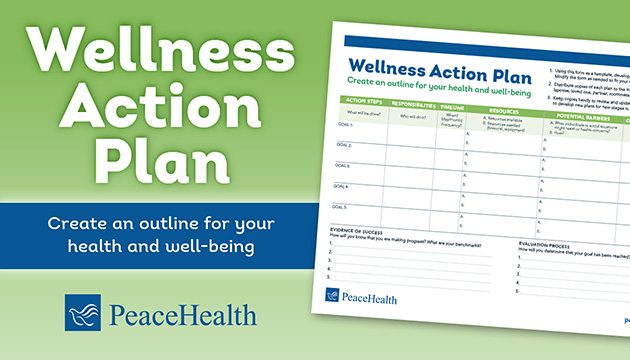5 tips for setting realistic health goals

Are you ready to adopt healthier habits? Here's how to plan for your success.
There’s no time like right now to adopt healthier habits that could help you feel better and live longer.
Whether you have diabetes, heart disease, arthritis or other condition, there are many things you can try to manage your health. From nutrition and exercise to sleep and stress management. All these and more can have a powerful impact on your physical and mental well-being, according to Cecelia Jacobson, a registered dietitian at PeaceHealth who helps patients with metabolic disorders, diabetes, cardiac, pulmonary and other medical issues.
Here are five tips she offers to plan for setting and achieving health goals:
1. Play to your strengths.
What do you find satisfying? Do you get excited about finishing what you started? Keep your first goal simple. Choose one to “check off” before taking on more. This will help build your confidence for your next goal.
Do you like a challenge? If you’re eager to stretch, go for it.
Whatever your personal style or level of ambition at this time, play to your strengths when you’re setting your goals.
2. Prioritize.
Consider one “big” area to work on that will make the biggest impact on your goal(s).
Carrying extra weight is a risk factor for many serious and sometimes life-limiting conditions such as heart disease and stroke. According to the CDC, being overweight or having a BMI over 30 can even lead to more severe cases of COVID-19. Losing as few as five or 10 pounds can make a significant difference.
Smoking or vaping is another area that’s well worth your attention since quitting the habit could cut your risk of developing cancer, respiratory problems and myriad other health issues.
If you’re at a healthy weight and you don’t smoke, focus on an area you feel will be most meaningful (e.g., nutritional choices, physical activity, mental health, etc.)
You may want to start by tracking your healthy habits. Track your water intake, sleep, mood and exercise with our printable guides.
3. Crawl, walk, run and celebrate!
Change doesn’t happen overnight. Take baby steps toward the change you want to make. And don’t be discouraged if you have a bad week. Use it as motivation to start fresh the next day.
Be sure your goals are SMART:
- Specific or Significant.
- Measurable or Meaningful.
- Attainable or Action Oriented.
- Relevant or Rewarding or Realistic.
- Time bound or Trackable.
Check this handout for “Crawl, Walk, Run” examples of SMART goals.
If losing weight is your primary goal, aim to lose between half a pound or up to two pounds per week. Set one SMART goal for diet or exercise to help you get there. For example, drink a cup of water before every meal or take a 10-minute walk after supper. These fit the SMART criteria and can help you make inroads on your weight loss.
Remember that it could take a few days or even weeks to see a difference so celebrate your milestones. Give yourself credit for how far you’ve come rather than looking only at how far you have to go.
4. Tap your support system.
If you have any kind of health conditions, be sure to check with your healthcare provider for advice first—especially before you change your diet or exercise routine.
Your primary care provider (or a specialist who helps you manage heart disease, diabetes or other chronic condition) is a great partner who can offer guidance and insight based on your personal health needs.
Use tools that match your goals and style. Several relatively low-cost fitness devices and free apps are available to help you track a variety of health goals. You can also choose paper-based tools or goal-setting worksheets.
Many exercise and other health classes are also now online. You might find a group or session on a virtual platform that will help you feel connected to others who are also trying to get healthy. Again, be sure to check with your doctor about any new exercise plan to make sure it’s right for you.
Talk with friends or family to stay accountable to your goals. As a bonus, your example might be the motivation they need to pursue their own goals.
5. Take the long view.
Ask yourself, “Why do I want to make this change?” Your answer can help you stay motivated if the going gets tough.
Do you want to spend quality time with the grandkids? Do volunteer work? Enjoy favorite hobbies? Try new things? Setting and achieving health goals can help you stay physically and mentally fit for whatever your plans might include. Even if you can’t do some or all of what you want right now, your work today can prepare you for when you can.
Finally, what habits do you want to keep for the rest of your life? Look at older friends or family you might want to emulate as you get to be their age. See yourself making and practicing healthy lifestyle choices now that will carry you well into the future.
Learn more by watching Cecelia’s 30-minute webinar, Picture Your Health: Strategies for Setting Health Goals.





